- Understanding Potato Yield
- Variety Selection
- Seed Quality
- Soil Preparation
- Planting and Spacing
- Fertilization and Irrigation
- Pest and Disease Management
- Harvesting and Storage
- The Importance of Proper Storage
- Pre-Harvest Preparations
- 1. Timing
- 2. Curing
- 3. Cleaning
- 4. Sorting and Grading
- 5. Drying
- 6. Storage Containers
- 7. Storage Conditions
- Optimal Harvest Timing
- But Removing Tops
- Post-Harvest Handling
- 1. Sorting and Grading
- 2. Curing
- 3. Cleaning
- 4. Storage Conditions
- 5. Proper Packaging
- 6. Regular Inspection
- 7. Rotation
- 8. Monitoring Temperature and Humidity
- 9. Pest Control
- 10. Regular Ventilation
- Sorting and Grading
- Curing the Potatoes
- Storage Conditions
- Temperature
- Humidity
- Ventilation
- Light
- Pest Control
- Storage Container
- Temperature and Humidity Control
- Temperature
- Humidity
- Air Circulation
- Potato Storage Containers
- Regular Monitoring
- “Question-Answer”
- How can I prepare potatoes for storage?
- Why is it important to dry potatoes before storage?
- What should I do with damaged or diseased potatoes?
- Can I store potatoes in a refrigerator?
- How long can potatoes be stored for?
- What are the ideal storage conditions for potatoes?
- “Video” How To Plant Potatoes | Get 5 KG Potatoes From 1 Potato | SEED TO HARVEST
As potato farmers know, the success of the harvest doesn’t end in the field. In fact, the way you prepare your tubers for storage can greatly impact their quality and longevity. Whether you plan to sell your potatoes at the market or simply want to enjoy them for months to come, there are a few essential steps you should follow to ensure optimal yield.
One of the first steps is to carefully handle the potatoes during harvest. Damaged or bruised tubers are more susceptible to rot and disease during storage, so it’s crucial to handle them with care. Gently dig up the potatoes, taking care not to nick or cut them with your tools. Additionally, be sure to sort and separate any damaged or diseased potatoes from the healthy ones.
After harvest, it’s important to cure the potatoes before storing them. Curing is a process that allows the skins of the potatoes to harden, creating a protective layer that helps prevent moisture loss and disease. To cure your potatoes, spread them out in a warm, well-ventilated area for about two weeks. During this time, the potatoes will develop a thicker skin, which will contribute to their longevity in storage.
Once your potatoes have been cured, it’s time to prepare them for storage. The key here is to create the right conditions for long-term storage, while also protecting the potatoes from moisture, light, and temperature fluctuations. Start by sorting your potatoes once again, removing any potatoes that show signs of rot or disease. Next, place the potatoes in ventilated storage containers, such as burlap sacks or baskets, which will allow for proper airflow. Store the potatoes in a cool, dark place with a consistent temperature of around 45-50°F (7-10°C), to prevent sprouting and spoilage.
By following these essential steps for preparing tubers for storage, you can significantly increase the yield of your potato harvest. Not only will your potatoes stay fresh and delicious for months, but you’ll also have a bountiful supply to enjoy throughout the year. So whether you grow potatoes for personal consumption or for sale, taking the time to properly prepare and store them will ensure you get the most out of your crop.
Understanding Potato Yield
Potato yield refers to the amount of potatoes that can be harvested from a given area of land. It is an important factor for potato farmers, as it directly affects their profits and overall success of the crop. Understanding how potato yield is determined can help farmers make informed decisions and implement effective strategies to increase their yield.
Variety Selection
The choice of potato variety plays a significant role in determining the yield. Different potato varieties have different growth characteristics and yield potentials. Some varieties are more suitable for specific climatic conditions or soil types, while others may have better resistance to pests and diseases. Farmers should carefully analyze the characteristics of different varieties and choose the one that is most likely to provide a high yield in their specific growing conditions.
Seed Quality
The quality of the seed used for planting is another crucial factor that affects potato yield. High-quality seed potatoes are those that are certified disease-free and have good sprouting and storage abilities. Using inferior or diseased seed potatoes can result in poor sprouting, reduced plant vigor, and lower yield. It is important for farmers to obtain high-quality seed from reliable sources to ensure optimal yield potential.
Soil Preparation
Proper soil preparation is essential for maximizing potato yield. The soil should be well-drained, loose, and rich in organic matter. It is recommended to perform a soil test to determine its nutrient content and pH level. Based on the test results, farmers can add appropriate fertilizers and amendments to optimize the soil conditions for potato growth. Adequate soil preparation provides the necessary environment for healthy root development and maximizes the potato yield.
Planting and Spacing
The planting technique and spacing also impact potato yield. Planting should be done at the right time, typically when the soil temperature reaches a certain threshold. Proper spacing between plants allows for good air circulation and reduces competition for nutrients. The spacing requirements may vary depending on the potato variety and the desired tuber size. Farmers should closely follow the recommended guidelines for planting and spacing to achieve optimal potato yield.
Fertilization and Irrigation
Providing adequate nutrition and water is crucial for optimum potato yield. Potatoes are heavy feeders and require regular fertilization with balanced nutrients. A soil test can help determine the specific nutrient deficiencies and guide farmers in applying the right fertilizers. Additionally, regular irrigation is necessary to ensure that potatoes receive sufficient water for growth and tuber development. Proper fertilization and irrigation practices contribute to healthy plant growth and higher potato yields.
Pest and Disease Management
Pests and diseases can significantly reduce potato yield if not properly managed. It is important for farmers to identify common pests and diseases that affect potatoes in their region and implement appropriate control measures. This may include the use of pest-resistant varieties, crop rotation, regular monitoring, and timely application of pesticides or biological controls. Effective pest and disease management practices help protect the crop and preserve its yield potential.
Harvesting and Storage
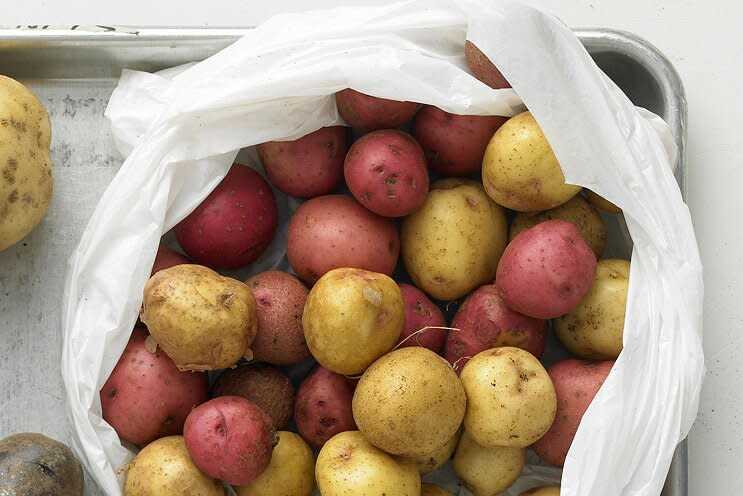
The way potatoes are harvested and stored also impacts their overall yield. Potatoes should be harvested at the right time when the tubers have reached their desired size and maturity. Care should be taken to avoid bruising or damaging the potatoes during harvest, as this can lead to storage losses. After harvesting, potatoes should be stored in a cool, dark, and well-ventilated area to reduce the risk of decay and maintain their quality. Proper harvesting and storage practices help preserve potato yield and prevent post-harvest losses.
In conclusion, understanding potato yield requires considering various factors such as variety selection, seed quality, soil preparation, planting techniques, fertilization, pest and disease management, and proper harvesting and storage practices. By implementing these essential steps, potato farmers can increase their yield potential and optimize their profits.
The Importance of Proper Storage
Proper storage of potatoes is essential to preserve their quality and extend their shelf life. When potatoes are not stored correctly, they can quickly deteriorate, leading to loss of yield and wasted resources. Here are some reasons why proper storage is important:
- Preventing rot and spoilage: Potatoes are susceptible to rotting and spoilage if they are exposed to moisture, light, or extreme temperatures. Proper storage helps minimize these risks and ensures that the potatoes remain fresh for a longer time.
- Minimizing sprouting: Sprouting is a natural process in potatoes, but it can be controlled through proper storage. Sprouted potatoes are not only aesthetically unappealing but also have an altered taste and texture. By providing the ideal storage conditions, sprouting can be minimized, leading to better-quality potatoes.
- Preserving nutritional value: Potatoes are a nutritious food source, rich in vitamins, minerals, and antioxidants. However, improper storage can lead to nutrient loss. By storing potatoes correctly, you can help preserve their nutritional value and ensure that you and your family are consuming healthy food.
- Reducing waste: Improper storage can result in a significant amount of waste due to spoiled potatoes. This not only causes financial losses for farmers and suppliers but also contributes to food waste on a global scale. Proper storage techniques can help minimize waste and ensure that potatoes reach consumers in optimal condition.
- Extending availability: For growers and suppliers, proper storage allows them to extend the availability of potatoes beyond the harvest season. By storing and managing potatoes correctly, they can meet consumer demands throughout the year, even when fresh harvests are not available.
In conclusion, proper storage is crucial for maintaining the quality, nutritional value, and shelf life of potatoes. By following the essential steps for preparing tubers for storage and implementing suitable storage techniques, you can ensure that your potatoes remain fresh and usable for an extended period.
Pre-Harvest Preparations
Preparing tubers for storage is a critical step in maximizing potato yield. Proper pre-harvest preparations ensure that the potatoes are in the best condition for storage and minimize the risk of disease and spoilage.
1. Timing
Timing is crucial when it comes to pre-harvest preparations. Harvesting the potatoes at the right time is essential for optimal yield and storage quality. Harvesting too early can result in underdeveloped tubers, while harvesting too late can lead to increased risk of disease and rot. It is important to monitor the crop and look for signs of maturity, such as yellowing foliage and senescence.
2. Curing
Curing the tubers after harvest is an important step in preparing them for storage. Curing allows the potatoes to heal any minor wounds, which reduces the risk of rot and disease during storage. To cure the potatoes, leave them in a well-ventilated area at a temperature of around 50-60°F (10-15°C) with high humidity for about two weeks. This process also allows the skin to thicken, which helps protect the tubers during storage.
3. Cleaning
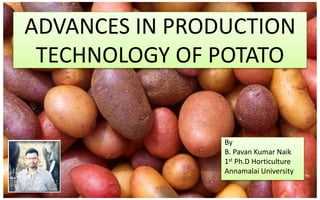
Before storing the potatoes, it is essential to clean them thoroughly. Remove any soil or debris from the tubers by gently brushing them or rinsing them with water. Cleaning the potatoes helps remove any potential sources of infection and keeps the storage environment clean.
4. Sorting and Grading
Sorting and grading the potatoes is important to ensure uniformity in size and quality. Remove any damaged, bruised, or diseased potatoes from the storage batch, as they can cause spoilage. Sort the potatoes according to their size and separate them into different storage bins or bags.
5. Drying
Before storing the potatoes, make sure they are dry. Excess moisture can promote rot and spoilage during storage. Allow the tubers to air dry for a few hours before placing them in storage containers. Avoid drying the potatoes in direct sunlight, as this can cause greening.
6. Storage Containers
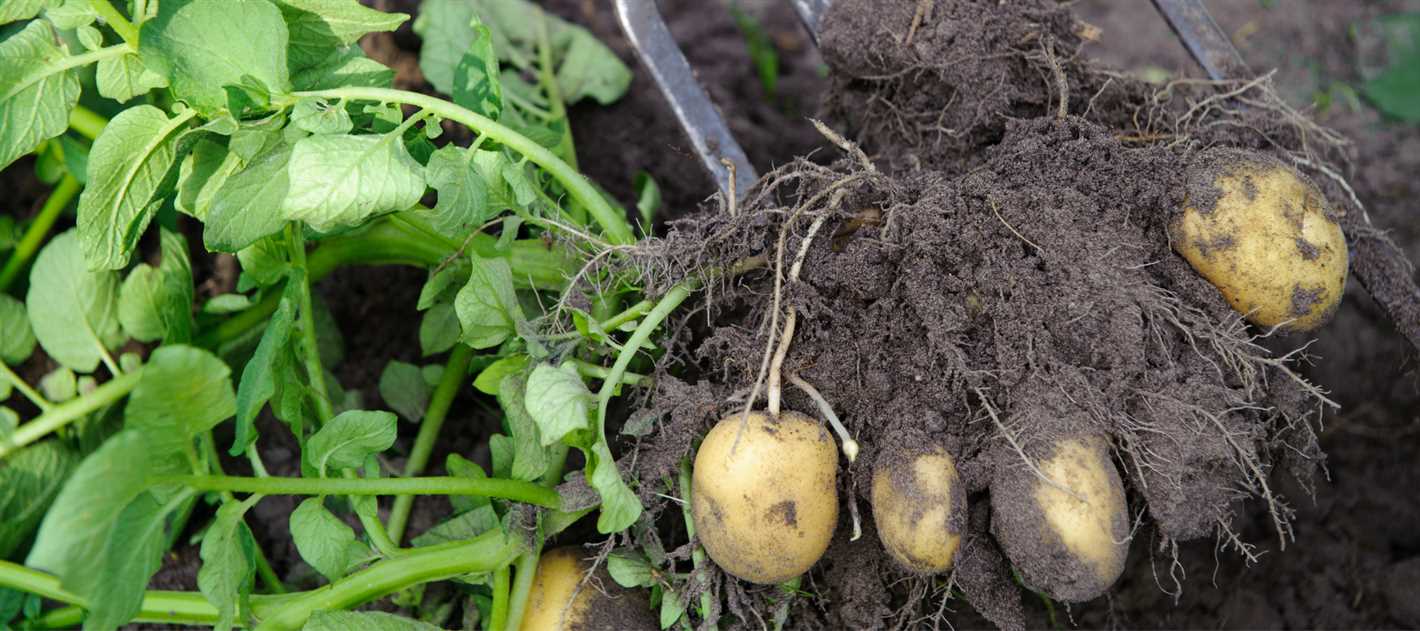
Choose appropriate storage containers for the potatoes. Good choices include well-ventilated crates, mesh bags, or burlap sacks. Avoid using plastic bags or sealed containers, as they can trap moisture and promote rot. Additionally, make sure the storage containers are clean and free from any dust or debris.
7. Storage Conditions
The final step in pre-harvest preparations is to store the potatoes in the right conditions. Potatoes should be stored in a cool, dark, and well-ventilated area with a temperature range of 35-40°F (2-4°C) and a relative humidity of 80-90%. Avoid storing potatoes near fruits or vegetables that release ethylene gas, as this can cause them to sprout or spoil.
By following these pre-harvest preparations, you can ensure that your potatoes are ready for storage and maintain their quality for a longer period of time.
Optimal Harvest Timing
One of the most important factors determining the yield and quality of potatoes is the timing of the harvest. Harvesting at the right time is crucial in maximizing the storage potential of the tubers and preventing losses due to rot or decay.
Here are some essential steps to determine the optimal harvest timing for potatoes:
- Observation: Start by observing the potato plants and their growth stage. Potatoes are typically ready for harvest when the foliage begins to die back and turn yellow. This signifies that the tubers have reached maturity and are ready to be harvested.
- Soil Sampling: Take soil samples to assess the maturity of the tubers. Digging a few plants and examining the size, skin texture, and color of the tubers can provide valuable insights into their maturity level.
- Brix Measurement: Using a refractometer, measure the Brix value of the potato tubers. Brix is a measure of the sugar content in the tubers and can indicate their maturity and quality. Higher Brix values typically indicate better storage potential.
- Test Dig: Perform a test dig by carefully digging up a few hills of potatoes. Examine the size, shape, and skin set of the tubers. If they meet the desired criteria for size and skin set, it is an indication that the crop is ready for harvest.
- Weather Conditions: Consider the weather conditions during the harvesting period. It is generally recommended to harvest potatoes during dry weather to minimize the risk of disease and rotting.
- Storage Time: Determine the intended storage time for the potatoes. Different varieties have varying storage potentials, with some being better suited for long-term storage than others. Harvest accordingly to ensure optimal storage conditions and prevent spoilage.
By carefully considering these steps and factors, farmers can determine the optimal harvest timing for their potato crop. Harvesting at the right time not only ensures maximum yield and quality but also minimizes losses during storage, ultimately contributing to a successful potato harvest season.
But Removing Tops
Before potatoes can be prepared for storage, the tops of the plants must be removed. This helps the potatoes go into a dormant state and prevents them from regrowing. Here are the essential steps for removing tops:
- Wait for the right time: It’s important to remove the tops when the plants have matured and started to die back. This usually happens around 2 to 3 weeks after the plants have flowered.
- Trim the tops: Using clean and sharp garden shears or scissors, trim the tops of the plants close to the ground. Be careful not to damage the tubers while doing this.
- Remove the tops: Once the tops are trimmed, collect and dispose of them properly. Do not compost them, as they can carry diseases or pests that might affect future crops.
By removing the tops, you help the potatoes enter a dormant state and focus their energy on developing the tubers. This step is crucial for successful potato storage and preventing regrowth.
Post-Harvest Handling
1. Sorting and Grading
After harvesting, potatoes should be sorted and graded to separate damaged, diseased, or undersized tubers from the healthy ones. This process helps to ensure that only high-quality potatoes are stored for long-term storage.
2. Curing
Curing is an important step in post-harvest handling that involves maintaining the harvested potatoes in a warm and humid environment for a period of time, usually 7 to 10 days. This process helps to toughen the skin and heal any wounds on the tubers, reducing the risk of storage diseases.
3. Cleaning
Before storing the potatoes, they should be thoroughly cleaned to remove any soil, debris, or plant material that may be present on the tubers. Cleaning can be done using a brush or gentle washing, but it is important to ensure that the potatoes are completely dry before storage.
4. Storage Conditions
Potatoes should be stored in a cool, dark, and well-ventilated environment to maintain their quality and prevent the growth of sprouts or diseases. The ideal storage temperature for potatoes is around 4-10°C (39-50°F) with a relative humidity between 85% and 95%.
5. Proper Packaging
Potatoes should be packed in breathable bags or containers that allow for good air circulation. Plastic bags should be avoided as they can create a humid environment that promotes the growth of molds and bacteria. Additionally, potatoes should not be stored with fruits or vegetables that release ethylene gas, as this can accelerate the sprouting process.
6. Regular Inspection
Stored potatoes should be regularly inspected to identify any signs of rot, sprouting, or decay. Damaged or spoiled tubers should be removed immediately to prevent the spread of diseases to the healthy potatoes. Regular inspection also helps to monitor storage conditions and make necessary adjustments to maintain optimal quality.
7. Rotation
It is important to practice a first-in, first-out (FIFO) system when using stored potatoes. This means using the oldest potatoes first and not keeping stored tubers for too long. By rotating the potatoes regularly, the risk of spoilage and the loss of overall quality can be minimized.
8. Monitoring Temperature and Humidity
The temperature and humidity levels in the storage area should be regularly monitored to ensure they remain within the recommended range. Fluctuations in temperature and humidity can negatively impact the quality and shelf life of stored potatoes.
9. Pest Control
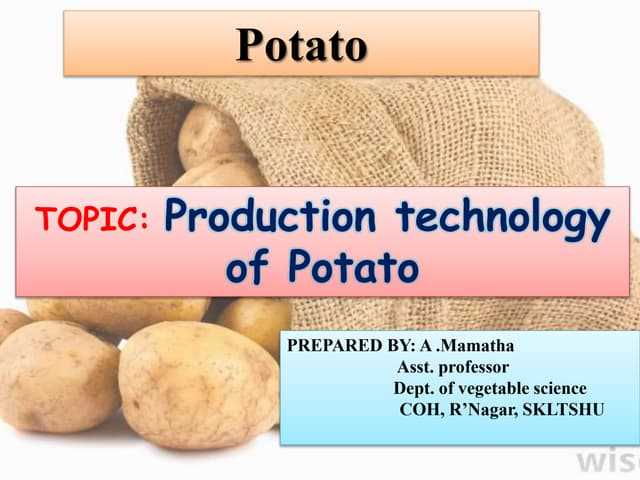
Proper pest control measures should be implemented to prevent infestations. This can include regular cleaning of the storage area, using suitable pest control methods, and inspecting stored potatoes for signs of pest damage.
10. Regular Ventilation
Adequate ventilation is essential for maintaining good air circulation and preventing the build-up of carbon dioxide, ethylene, and moisture in the storage area. Regularly opening vents or windows can help promote air exchange and maintain optimal storage conditions for potatoes.
Sorting and Grading
Sorting and grading potatoes is an essential step in the preparation for storage. This process helps to ensure that only high-quality tubers are kept for long-term storage, while damaged or inferior potatoes are discarded or used for immediate consumption.
There are several factors to consider when sorting and grading potatoes:
- Size: Potatoes should be sorted according to their size. This is typically done using mechanical equipment that separates the tubers based on diameter. Sorting by size helps to ensure uniformity and allows for easier storage and handling.
- Quality: During the sorting process, potatoes should be carefully inspected for any signs of damage, disease, or pest infestation. Damaged or diseased tubers should be removed to prevent the spread of infection during storage. It is also important to check for blemishes, such as black spots or bruising, as these can affect the overall quality of the stored potatoes.
- Shape: While not as critical as size and quality, sorting potatoes by shape can be helpful for storage purposes. Long, oval-shaped potatoes are generally easier to stack and store compared to irregularly shaped tubers. However, shape is not a determining factor in the overall quality of the potatoes.
- Color: Sorting potatoes by color is also a common practice. This is especially important for potatoes with colored flesh, such as red or purple varieties. Keeping different colors separate can help to maintain the visual appeal of the stored potatoes.
After sorting, graded potatoes are typically stored in ventilated crates or boxes, which allow for proper airflow and reduce the risk of rot or mold development. It is important to store the sorted and graded potatoes in a cool and dark environment to prolong their shelf life.
In conclusion, sorting and grading potatoes is an important step in ensuring the long-term storage of high-quality tubers. By considering factors such as size, quality, shape, and color during the sorting process, farmers and growers can increase the overall yield and profitability of their potato crops.
Curing the Potatoes
After harvesting, the potatoes need to go through a curing process before being stored. Curing helps the potatoes to develop a protective layer on the skin, which prolongs their shelf life and prevents them from rotting.
Here are the essential steps for curing potatoes:
- Clean the Potatoes: Start by removing any excess soil and debris from the potatoes. Use a dry cloth or a soft-bristled brush to gently brush off the dirt. Ensure that the potatoes are completely clean before proceeding to the next step.
- Dry the Potatoes: Place the cleaned potatoes in a cool, well-ventilated area for 1-2 weeks. This will allow the potatoes to dry out and the skin to harden. Avoid exposing the potatoes to direct sunlight, as it can cause greening and make them unsuitable for consumption.
- Avoid Washing the Potatoes: During the curing process, it is important to avoid washing the potatoes with water, as it can introduce moisture and promote the growth of bacteria and mold.
- Inspect for Damaged Potatoes: While the potatoes are drying, inspect them for any signs of damage or disease. Remove any potatoes with cuts, bruises, or signs of decay, as they can quickly spread to the other tubers and affect their quality.
- Store in a Cool, Dry Location: Once the potatoes have dried and the skin has hardened, they are ready for storage. Transfer them to a cool, dark location with a temperature of around 40-50 degrees Fahrenheit (4-10 degrees Celsius) and a humidity level of 85-95%. Avoid storing potatoes near fruits or vegetables that release ethylene gas, as it can cause the potatoes to sprout prematurely.
Curing the potatoes is a crucial step in ensuring their long-term storage success. By following these steps, you can maximize the yield and quality of your potato harvest.
Storage Conditions
After the potatoes are properly prepared for storage, it is important to create the right conditions to ensure their longevity. Here are some key factors to consider:
Temperature
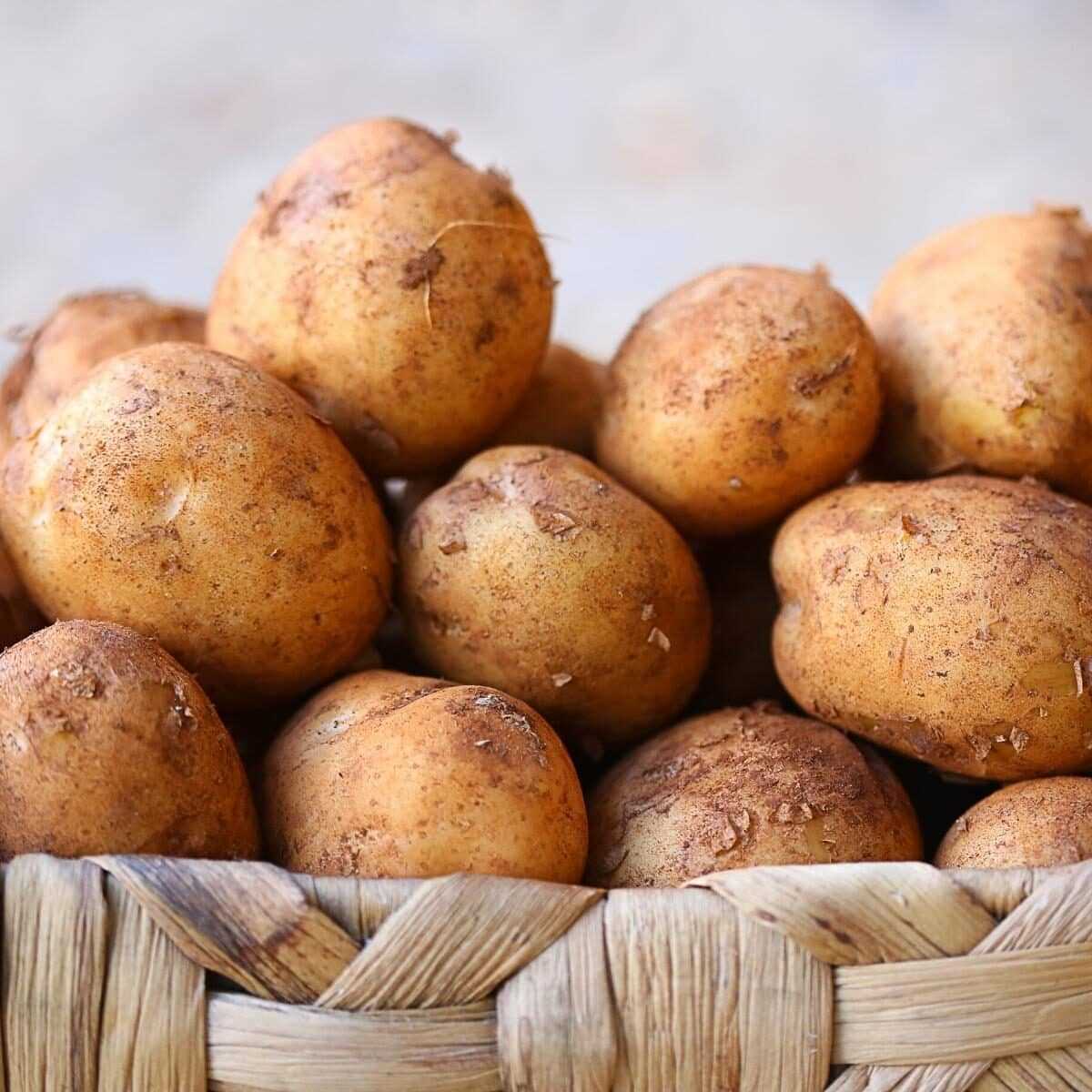
- The ideal temperature for storing potatoes is between 45°F (7°C) and 50°F (10°C).
- Temperatures below 40°F (4°C) can cause the potatoes to develop a sweet taste and turn dark when cooked.
- Temperatures above 50°F (10°C) can cause the potatoes to sprout and spoil quickly.
Humidity
- Potatoes should be stored in a humid environment to prevent them from drying out.
- The relative humidity (RH) in the storage area should be around 85% to 95%.
Ventilation

- Proper ventilation is necessary to prevent the build-up of excess moisture and to ensure adequate air circulation.
- Potatoes should be stored in a well-ventilated area to reduce the risk of rotting.
Light
- Potatoes should be stored in a dark place to prevent them from turning green.
- Exposure to light can cause the potatoes to produce chlorophyll, resulting in a bitter taste and potential toxicity.
Pest Control
- Regularly check the stored potatoes for signs of pests or diseases.
- If any pests are found, remove the affected potatoes immediately to prevent further contamination.
- Keep the storage area clean and free from debris to minimize the risk of attracting pests.
Storage Container
- Use breathable containers, such as burlap bags or mesh sacks, to store potatoes.
- Avoid using plastic bags or airtight containers, as they can trap moisture and contribute to rotting.
- Ensure that the storage containers are clean and well-maintained to prevent the transfer of diseases or pests.
By following these storage conditions, you can maximize the shelf life of your stored potatoes and ensure that they remain fresh, healthy, and delicious for an extended period of time.
Temperature and Humidity Control
Proper temperature and humidity control are essential for storing potatoes and maintaining their quality. Here are some important factors to consider:
Temperature
The ideal temperature for storing potatoes is between 45°F (7°C) and 50°F (10°C). At this temperature range, the potatoes will remain dormant and won’t sprout or decay quickly. Storage temperatures below 45°F (7°C) can cause the potatoes to become sweet and develop an off-flavor.
It’s important to avoid storing potatoes at temperatures above 50°F (10°C) as higher temperatures can lead to sprouting, which reduces the overall quality and shelf life of the tubers.
Humidity
The humidity levels in the potato storage area should be maintained at around 90% to 95%. Higher humidity helps to prevent excessive moisture loss from the potatoes, which can result in shrinkage and shriveled tubers.
It’s crucial to have good insulation and an adequate ventilation system in the storage area to control humidity levels. Excessive moisture in the storage area can lead to the growth of fungi and bacteria, resulting in decay and spoilage of the potatoes.
Air Circulation
Proper air circulation is essential for maintaining uniform temperature and humidity throughout the potato storage area. This helps to prevent the formation of moisture pockets and ensures that the entire batch of potatoes is stored in favorable conditions.
It’s recommended to use fans or other ventilation systems to ensure adequate air circulation. This also helps in reducing the buildup of carbon dioxide and other harmful gases, which can promote decay and affect the quality of the potatoes.
Potato Storage Containers
When storing potatoes, it’s important to use suitable storage containers that allow for proper ventilation. Wooden crates or breathable bags made of materials such as burlap are good choices. Avoid using plastic bags or airtight containers, as they can lead to excessive moisture buildup and faster decay.
Regular Monitoring
Regularly monitoring the temperature and humidity levels in the potato storage area is crucial. Use a thermometer and a hygrometer to check the conditions periodically. If any issues are detected, adjustments can be made to correct them and ensure optimal storage conditions for the potatoes.
By carefully controlling the temperature and humidity levels, as well as ensuring proper air circulation and using suitable storage containers, you can maximize the shelf life and maintain the quality of your stored potatoes.
“Question-Answer”
How can I prepare potatoes for storage?
To prepare potatoes for storage, start by harvesting them when they are fully mature. Then, let them dry in a cool, dark place for about two weeks. After drying, sort the potatoes and remove any damaged or diseased ones. Finally, store the potatoes in a cool, dry, and well-ventilated area.
Why is it important to dry potatoes before storage?
Drying potatoes before storage is important because it helps to toughen their skin and promote the healing of any wounds. This prevents the potatoes from rotting and extends their shelf life.
What should I do with damaged or diseased potatoes?
If you have any damaged or diseased potatoes, it is best to remove them before storing the rest. Damaged or diseased potatoes can spread rot to the healthy ones, causing them to spoil quickly.
Can I store potatoes in a refrigerator?
It is not recommended to store potatoes in a refrigerator. The low temperature and moisture in the refrigerator can cause the potatoes to become sweet and darken when cooked. It is best to store them in a cool, dry, and well-ventilated area, such as a cellar or a pantry.
How long can potatoes be stored for?
Potatoes can be stored for several months if they are properly prepared and stored in ideal conditions. It is important to regularly check the stored potatoes for any signs of rot or spoilage and remove any affected ones to prevent the spread of decay.
What are the ideal storage conditions for potatoes?
The ideal storage conditions for potatoes include a cool temperature of around 45 to 50 degrees Fahrenheit (7 to 10 degrees Celsius) and a humidity level of around 85 to 90 percent. It is also important to store potatoes in a well-ventilated area to prevent the buildup of moisture.







